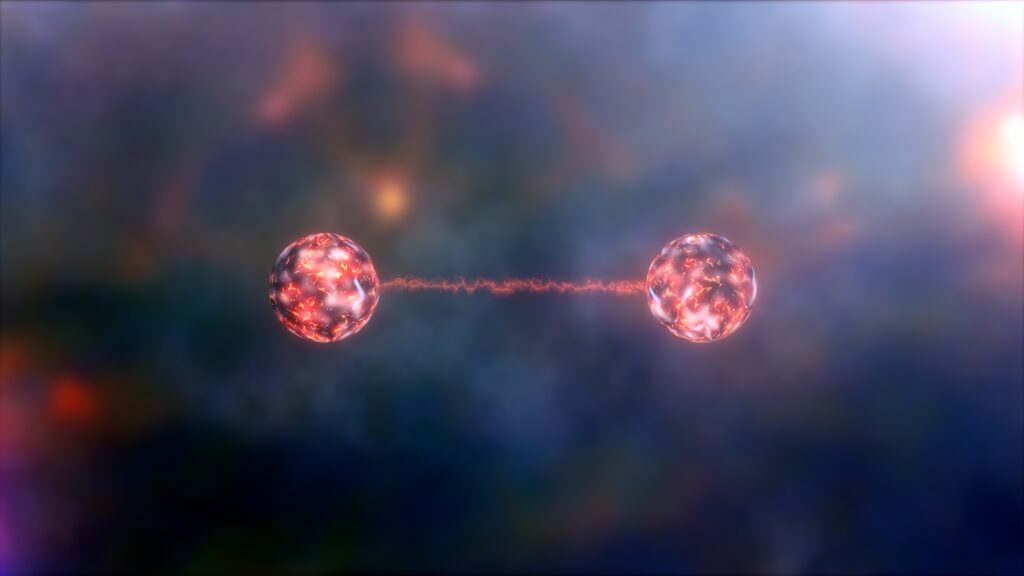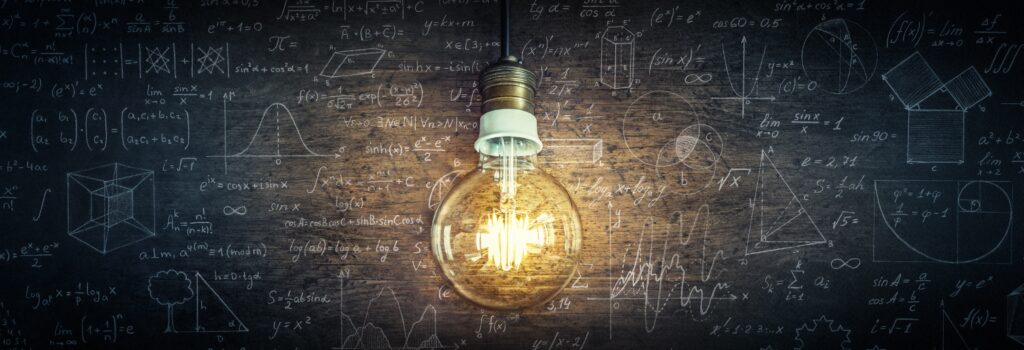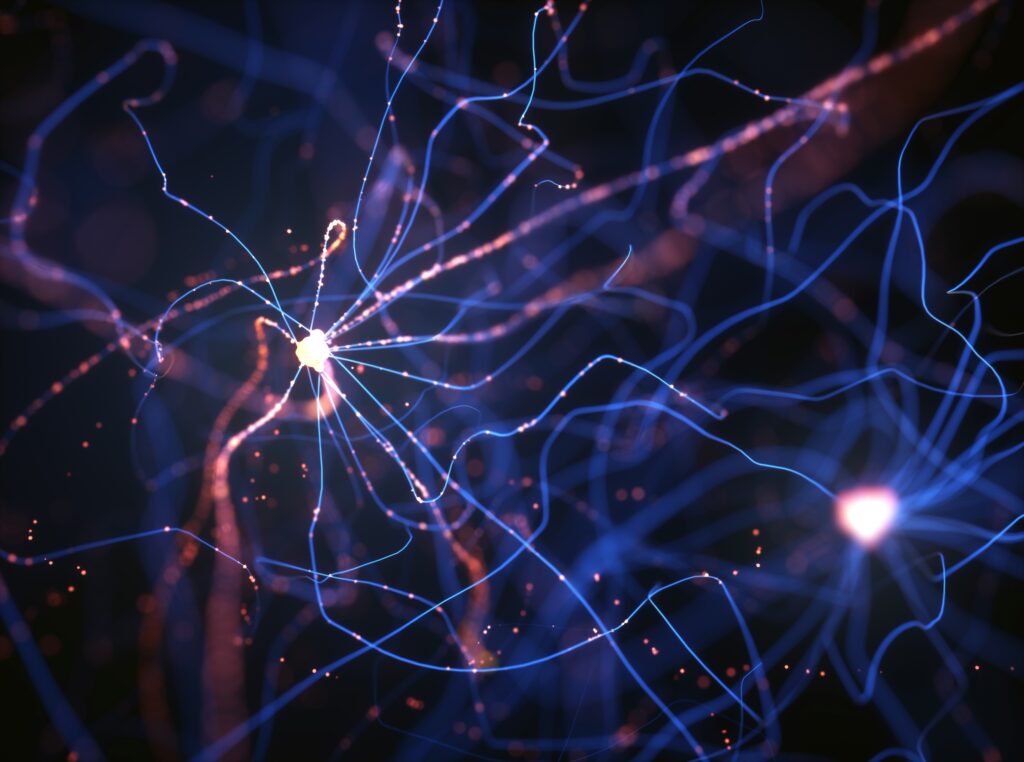Best way forward or unnecessary detour? A review of “Dual-Aspect Monism and the Deep Structure of Meaning”
Reading | Metaphysics
![]() Prof. Edward F. Kelly, PhD | 2023-08-27
Prof. Edward F. Kelly, PhD | 2023-08-27

The essay below is our first long-form book review. The target book is Dual-Aspect Monism and the Deep Structure of Meaning, by Harald Atmanspacher and Dean Rickles, Routledge, New York, 2022. Prof. Kelly argues that the dual-aspect monism defended in this book represents an unnecessary side path in the search for a successor to physicalism, and that idealism is a better option. Atmanspacher’s and Rickles’ assertion that “The deep structure of meaning is a unique attribute of the dual-aspect approaches” is simply incorrect, for a deep structure of meaning is inherent in consciousness itself, and consciousness is fundamental to idealism in general.
The science-based picture of the world that currently dominates mainstream psychology and neuroscience, and that constitutes the received wisdom of “opinion elites” worldwide, is physicalism, a desiccated philosophical descendant of the materialism of previous centuries. Anchored to the mature classical physics of the late 19th century, this doctrine conceives of reality as a whole in essentially the same way that major early scientists such as Galileo and Newton had conceived of its physical aspects alone—i.e., setting aside consciousness and all other things mental or spiritual (which they themselves took very seriously) for the sake of progress in physics as the prototypical observational and mathematical science. On this view, in its modern philosophical form, reality consists at bottom of some sort of enduring self-existent bits of matter moving about under the influence of fields of force in accordance with mathematical laws in a ready-made container provided by space and time, and all else including our human minds and consciousness must get manufactured somehow from that basic “stuff”. We are nothing but immensely complicated biological machines, operating deterministically like everything else in a clockwork universe, and “rogue” phenomena such as paranormal or “psi” processes and postmortem survival are simply impossible, ruled out by the laws of physics. On a broader scale we see no sign in nature of formal or final causes or indeed anything transcending the physical world, and the more we learn about that world the more it seems devoid of purpose or meaning.
This bleak and impoverished worldview is increasingly recognized as contributing directly and indirectly to the manifold crises threatening contemporary civilization, and it has understandably provoked attacks from many quarters. What matters most for my purposes here, however, is that its purported empirical basis and justification has been progressively undermined in recent times by emerging developments within science and philosophy themselves. Experimental and case-study evidence for the reality of psi, for example, continues to accumulate, and this is just one of many well-established psychophysical phenomena that demonstrably outstrip the capacities of the unaided physicalist brain (Kelly, Kelly, Crabtree, Gauld, Greyson & Grosso, 2007). Many philosophers of mind and even some prominent neuroscientists such as Francis Crick’s protégé Christof Koch now openly doubt that a physicalist explanation of consciousness will ever prove possible, and of course the tectonic shudders in the foundations of physics initiated by the rise of relativity and quantum theories in early C20 have continued reverberating down to the present day, with no full and universally-accepted understandings of their implications for physics and philosophy yet in sight.
We seem to be at or near a major inflection point in modern intellectual history. Let me underscore here at the outset, however, that what warrants attack is not science itself but an inadequate philosophical doctrine grounded in trailing-edge science. What many of us who have rejected that doctrine are currently groping toward is something worthy of supplanting it—some sort of expanded but still science-based conceptual framework, or worldview, or metaphysical system that at least makes room for (and if possible “explains” in some agreed-upon sense) rogue phenomena such as those indicated above.
Among the many such positions currently on offer, two main families seem to me the most promising. First is a family of realist (vs. Berkeleyan or subjective) idealisms of the sort emerging as the central tendency from a decades-long project, sponsored by Esalen Institute’s Center for Theory and Research, which examined representative mystically-informed religious philosophies along with various Western metaphysical systems and some modern physics-based positions, all of which take the indicated rogue phenomena seriously (Kelly et al., 2007; Kelly, Crabtree & Marshall, 2015; Kelly & Marshall, 2021). More on these later. Second is a family of dual-aspect monisms, of which the volume under review represents an important member. All of these are motivated at least in part by the understandable urge to preserve and build upon the undeniable theoretical and practical achievements of science as it has evolved so far, and most try to accomplish this by adding something mental or experiential to the physical world as conventionally conceived. Microphysicalist or constitutive panpsychisms, for example, assign proto-mental properties to the basic elements of a physicalist conception, but then face serious challenges in terms of explaining how higher-order consciousness and mentation emerge through composition of these lowest-level entities. Interest seems to be increasing at present in alternative “cosmopsychist” or decompositional versions of panpsychism that attribute some sort of consciousness or mentality to the physical universe as a whole, and attempt to derive the mentality of lower-level constituents from that. For further information about these ongoing developments see for example Seager (2020), Goff (2017), Shani & Keppler (2018), Velmans & Nagasawa (2012), and the chapter by Velmans in Kelly & Marshall, 2021.
Polymath Harald Atmanspacher, a native speaker of German with high-level skills in physics, philosophy of mind, and cognitive neuroscience, has been the primary developer, expositor, and promoter of a unique variant of dual-aspect monism deriving from the intense, protracted, and until recently largely hidden mid-C20 collaboration between psychiatrist Carl Gustav Jung and Nobel Prize physicist Wolfgang Pauli. In the present volume he joins forces with historian and philosopher of physics Dean Rickles to introduce a significant new extension of that basic framework, and to enlist four other eminent and philosophically inclined modern physicists—Arthur Eddington, John Archibald Wheeler, David Bohm, and Bohm’s long-term collaborator Basil Hiley—in support of the extended theory.
Atmanspacher and Rickles (henceforth “A&R”) have certainly produced a significant new contribution, densely packed with information of interest to readers of many kinds. I believe, however, for reasons I will attempt to explain in what follows, that they have taken an unnecessary detour and should instead align themselves more closely with the realist-idealist camp.
I will begin by summarizing the book’s main contents. A brief Introduction captures some highlights of the picture A&R will develop and outlines the structure of the book. In contrast with traditional physicalist, idealist, and dualist understandings of the brain/mind relation—which take matter, mind, or both, respectively, as ontologically fundamental—the Jung/Pauli/Atmanspacher picture (henceforth JPA) treats mind and matter as purely epistemic or experiential aspects of reality, aspects that emerge in necessarily correlated fashion through “decomposition” of an underlying ontic realm of a sort suggested by Jung’s dynamic psychology in combination with key features of quantum theory such as complementarity and entanglement. This ontic realm may contain features and structures of its own but is said to be psychophysically neutral (PPN) with respect to the mind/matter distinction. On this view no direct causal interactions occur in either direction between the mental and physical aspects of reality as we normally experience it. The newest and even more surprising part of the theory, to be emphasized throughout this book, is that A&R now see the deep structure of meaning, understood as something like sense or semantic content, as a crucial part of the basic fabric of reality, enfolded within the underlying PPN domain and governing its decompositions into mental and physical aspects.
The book has three main parts. Part I, providing much useful background, consists of two chapters. The first again sketches the main features of the position to be advanced and then touches briefly upon a number of historical figures and doctrines that A&R view as contributing to its development. These include in particular some pre-Socratic sources; Plotinus and the later Neoplatonists; Descartes, Leibniz, and (with special emphasis) Spinoza; the German idealists Fichte, Schelling and Hegel; Kant and Schopenhauer with their differing views on access to the assumed noumenal background of phenomenal experience; the neutral monisms of James, Mach, and Russell; and Chalmers’s more recent attempt to characterize ongoing experience as the “flux” of an underlying ontic reality consisting of classical Shannon-type “information”. The chapter ends by characterizing the JPA position as a novel solution to the traditional philosophical problem of the One and the Many—specifically, a form of priority monism in which the underlying One, the PPN realm, is ontologically fundamental, but the epistemic Many are no less real.
Chapter 2 provides a similar lightning tour of relevant modern discussions of varieties of meaning. Successive sections are devoted to intentionality in Brentano and Husserl; Frege’s fundamental distinction between sense and reference; Cassirer’s work on symbolic forms; Wittgenstein’s emphasis on implicit semantic content or stage-setting as conditioning the meaningful use of language; the intentional arc or action-perception cycle from Merleau-Ponty to ecological psychology; Von Weizsäcker’s work on “pragmatic information” as an objective surrogate for semantic meaning; the “felt sense” of psychologist Eugene Gendlin, who (somewhat like Wittgenstein) highlighted the crucial role of elaborate semantic contexts operating beyond consciousness awareness in shaping human communicative, therapeutic, and creative endeavors; and philosopher Markus Gabriel’s analysis of making sense as the conscious grasping of meanings—something that we but not our computers can do.
Part II, comprised of three chapters, constitutes the heart of the book. The first and most critical is Chapter 3, in which A&R lay out in greater detail the baseline or canonical version of the JPA framework as originally developed by Pauli and Jung and now being extended by them. They begin by restating that framework in somewhat more formal fashion, partly to facilitate comparison with the related frameworks to be discussed in following chapters, and partly to clarify its connections with quantum theory. Psychophysical correlations are portrayed as many-to-many in form, and neither effective-causal nor random but arising somehow from meanings enfolded within the underlying PPN domain. Here as elsewhere in the book A&R speak of mind-matter correlations as being “substantiated” (which I take to mean “made substantial” or perhaps “actualized”) by such meanings, and here they go on to illustrate what they have in mind by reference to Jung’s concept of synchronicity — unusual and meaningful coincidences between mental and physical events that are neither random nor explainable in conventional efficient-causal terms. A further analogy between quantum theory and Jung’s dynamic psychology inspires a distinction between structural and induced mind-matter correlations, where the former are more or less mechanical and highly reproducible correlations reflecting the operation of deep archetypes as ordering factors in nature (analogous to Platonic forms), and the latter are relatively idiosyncratic and unreproducible correlations associated with more superficial archetypes responsive to the vagaries of human emotions and needs. The induced correlations in particular can produce back-reactions into the PPN substrate, and this leads in turn to a novel typology of exceptional experiences which they discuss at some length (see also the chapter by Atmanspacher & Fach in Kelly et al., 2015). Subsequent sections sketch additional applications of the basic framework to topics including biological evolution and scientific creativity. Pauli was deeply skeptical of the standard neo-Darwinian assumption of random mutations, and saw the PPN realm as harboring quasi-Lamarckian possibilities for evolution which as A&R explain have been at least partially confirmed by more recent developments in that area. He was also sympathetic to Platonism in mathematics, and understood the inspiration phase of the creative process as an upwelling in symbolic form of archetypal contents from the PPN realm into waking consciousness (see also Kelly et al., 2007, Chapter 7).
A central theoretical issue for the JPA framework concerns the structure and content of the hidden PPN realm, and this issue is most directly addressed in a final section of Chapter 3 devoted to archetypes, symbols, and the Unus Mundus (section 3.7, p. 71). A&R first briefly review the history of Jung’s evolving conception of archetypes as ordering factors underlying the regularities in our experience of nature, and as the main structural components of a collective unconscious located somewhere beyond the personal unconscious contemplated by Freud and other early psychoanalysts. Jung initially thought of these as heritable components of brain architecture, but they ultimately assumed a “psychoid” form outside the personal psyche and metaphysically prior to any distinction between mind and matter. Pauli strongly supported this move, but insisted also that archetypes be conceived as actively exerting their ordering effects, rather than as static Platonic forms passively inhabiting some sort of intelligible realm. Activated archetypes produce symbols which partly express but do not exhaust their content, expressing deep meanings that cannot be expressed in any other way. As Pauli put it in describing his “new idea about the nature of reality” (p. 74): “On the one hand, a symbol is a product of human effort, on the other hand it indicates an objective order in the cosmos of which humans are only a part.”
The ontologically fundamental PPN realm as pictured in the JPA framework derives directly from Jung’s long-held neo-Kantian view of the dynamic unconscious as inherently dark and inaccessible to conscious experience but stratified somehow in depth. As A&R acknowledge in the final section of this chapter, however (section 3.7.2, p. 77), Jung himself significantly modified that picture in his last great work, arguing (with help from the C16 alchemist Gerhard Dorn) that the underlying reality must have a “bottom” level taking the form of an Unus Mundus or totally undivided unity devoid of any distinctions whatsoever, and embracing the idea that the PPN realm in general is directly accessible to conscious experience after all, at least under special conditions. I will return to this theoretically crucial subject in the essay section below.
Chapter 4 focuses on relevant work of physicists Arthur Eddington and John Archibald Wheeler, who are linked conceptually by their theoretical views and practically through Wheeler’s student and long-time friend Peter Putnam, who wrote a large treatise on Eddington and introduced Wheeler to elements of Eastern philosophic thought. Breaking with classical physics, which sharply distinguishes observers from a supposedly independent, self-existent external world of objects under observation, both men envisioned a more important role for conscious observers—specifically, that by virtue of the manner in which they pose questions to nature they act as co-creators of experimental outcomes, and more generally that they serve as agents for the conversion of possibility into actuality (p. 83). Wheeler explored this subject in considerable depth, ultimately concluding that everything in the experienced physical world originates in a hidden immaterial “something” having information-theoretic characteristics. He often talked about this something in relation to a scenario in which the observer poses a series of questions to nature in binary (yes/no) form, thereby successively reducing an initially large array of possibilities to the one outcome that actually occurs, and of course each such decision can be thought of as generating one “bit” of syntactic Shannon-type “information”. Wheeler’s widely-quoted slogan “it from bit”, summarizing his vision of how the experienced world arises from an informational substrate, has often been misunderstood by others (including David Chalmers) in precisely this way, in effect interpreting it as saying “everything is (Shannon) information”, but Wheeler’s own views are more subtle and interesting. For him, meaning is what is really fundamental, and a new fact enters the observed universe specifically through the actions of a conscious observer actively participating in a “meaning circuit” linking that observer to what is being observed. As suggested by delayed-choice experiments, even some facts about the distant past might be established in this way by actions occurring now. A better translation of “it from bit”, say A&R, is therefore “everything is meaning” (p. 105; see also p. 31, p. 85, p. 104 note 33, p. 109, and p. 165). The chapter concludes by noting various resonances between the participatory realisms of Eddington and Wheeler and the work of other modern physicists including Niels Bohr, Max Born and Chris Fuchs.
Chapter 5 pairs David Bohm with his long-term collaborator Basil Hiley, portraying Bohm as the main source of their shared theoretical ideas and Hiley as securing and extending the technical foundations. Bohm’s views like those of Jung evolved constantly, but the parallels are certainly striking. Seager (2013, 2018) had already made a strong case for taking Bohm seriously as a dual-aspect monist and panpsychist, but A&R attempt to enlist him more specifically in support of their JPA variant. Bohm’s explicate order, like JPA’s epistemic mental and physical actuality, arises from a hidden implicate order in which all potentialities are enfolded (p. 124), and the unfolding is governed by meaning, which in Bohm’s case resides in his concept of active information (p. 133). Like JPA and Wheeler as well, Bohm portrays such meaning as giving form to actuality, functioning in effect like an Aristotelian formal cause. The implicate order is non-Boolean in character, and its elements are connected and ordered in terms of relations prior to those of space and time that we find in the explicate or actualized order (p. 141). It is also dynamic, filled with activity—a holomovement— and contains active elements analogous to Jungian archetypes. Here A&R cite the interesting example of Goethe’s Urpflanze or primordial plant (p. 140), construed by them as an archetype which acts like a generating function in mathematics to create an infinite variety of specific morphologies from an abstract template. In a further parallel with JPA’s stratified ontic domain, Bohm ultimately posited a hierarchy of levels within the implicate order itself, such that a given level can simultaneously be implicate with respect to a higher level and explicate with respect to a lower, accommodating a concept of “relative onticity” (p. 129). In a concluding section devoted to Bohm’s spiritual turn in dialogue with Krishnamurti, A&R note that Bohm was more open than Jung to the possibility that the hidden order terminates in a totally undifferentiated unity of some indescribable sort to which we humans potentially have experiential access, and that he found real hope in that direction for our individual and collective salvation.
Part III, “Discussion and Perspectives”, consists of two additional chapters. A short but difficult Chapter 6 concentrates on features shared among the systems described in Part II, focusing initially on some large-scale commonalities and differences of emphasis. Jung and Pauli clearly represent the primary source of the JPA framework, combining Jung’s dynamic psychology with insights derived by Pauli from quantum theory, while the four additional physicists discussed in Part II are taken as confirming and refining that basic framework in various ways, particularly in validating its new emphasis on meaning as a “basic ingredient in the metaphysical constitution of nature” (p. 156), and in providing possible ways of more formally characterizing the PPN realm and its emergence into the world we experience. All agree that reality is ultimately an undivided whole, without parts, and that our normal everyday experience of ourselves as sentient actors operating in a shared physical environment emerges somehow in cooperation with something normally hidden that underlies it. Even space and time themselves appear to the physicists of Part II not to pre-exist but to emerge in some such way. Other shared or at least partly-shared opinions about the nature of that hidden something are that it is the primary abode of the possible, which they insist is fully as real as the actual (p. 79); that its organization may include something like the Jungian hierarchy of archetypes with an undifferentiated Unus Mundus at the bottom (and perhaps additional contents such as mathematical realities and Platonic forms of Beauty, Truth and Goodness); and that its operating principles are non-Boolean in character, permitting it to ignore ordinary logical strictures such as the laws of non-contradiction and excluded middle (as revealed for example in the “primary process” mentation underlying much artistic creation, dreams, and myth). All of the frameworks described in Part II also share a conviction that the character of the hidden realm is at least partly understandable or describable in terms of logical and algebraic systems associated with the foundations of quantum theory (p. 157). The chapter ends by comparing the ways in which the deep structure of meaning enters into the three approaches: The parallel understandings are most evident between the Jung-Pauli treatment of synchronicities and Bohm-Hiley’s treatment of active information as mediating the unfolding of implicate to explicate orders, but semantic meaning is also involved from the Eddington-Wheeler perspective in every created “phenomenon” or observational occurrence (p. 163).
Chapter 7 presents a variety of topics for future research that A&R see as flowing from their dual-aspect model. One concerns various psychological phenomena that might reflect quantum-type properties of the PPN realm, such as the dependence of answers provided to questionnaire items on the order of presentation of the questions (non-commutative operations). Another would be further studies of temporal non-locality effects in bistable perception (p. 144). Relying on authors such as Fields Medalist Alain Connes, Spencer Brown, Roger Penrose and Eugene Wigner, as well as Jung and Pauli themselves, A&R more explicitly endorse a version of mathematical Platonism which specifically identifies the PPN realm as containing the sorts of realities that great mathematicians discover, thereby providing a “perfectly reasonable” explanation for Wigner’s “unreasonable effectiveness of mathematics” (p. 188). A large part of the proposed work concerns possible paths toward more complete logical/algebraic formalization of the JPA picture, particularly in regard to the structure and content of the PPN realm and the processes of “emergence” by which it gives rise to the epistemic physical and mental realms.
A&R also suggest various possible ways of studying exceptional experiences more deeply in relation to the theory-driven taxonomy presented in Chapter 3, and here I must register a major complaint: Their interest in spontaneous cases is certainly justified and welcome, but in a single short paragraph and accompanying footnote on p.189 they go on to dismiss the entire history of experimental parapsychology as generically incompetent and/or lacking significant results, and not only that but fundamentally irrelevant and misguided as well. These sweeping negative judgments are unworthy of A&R and their book, revealing an ignorance of the experimental psi literature that is nothing short of shocking. It is also ironic, to put it mildly, that their judgments starkly conflict with those of Jung and Pauli themselves, both of whom regarded the experimental results of J. B. Rhine as compelling and deliberately wove them into their own theoretical efforts (personal communication from Roderick Main, June 24, 2023). For a recent survey of relevant experimental literature with numerous pointers see Cardeña (2018).
The following section of Chapter 7 briefly discusses generation of meaning in phylogenetic and ontogenetic evolution, along with possible objective surrogates (measures of “pragmatic information”) applicable to physical and biological systems, and a concluding section on Deep Ecology (p. 192) begins to explore ways in which a JPA-like worldview could potentially have positive consequences for society and civilization as a whole.
Chapter 8 encapsulates in 2 ½ pages the meteoric modern rise and current troubles of physicalism, and touts A&R’s brand of dual-aspect monism as an ideal candidate to succeed it. The book then ends with an 18-page bibliography and a moderately useful index.
The preceding description barely begins to do justice to this slender but remarkably rich and densely-packed volume, which definitely merits attention from anyone actively engaged with current mind/matter theorizing. But having now summarized its main themes and contents as best I can, I must go on to explain why I think JPA takes us down a side path.
I begin with an important disclaimer. This book is deliberately weighted toward physics and physicists, with a certain amount of physics/math chauvinism evident throughout, and much of its technical content is beyond the reach of more general readers such as myself. Taking forms such as offhand and parenthetical remarks, footnotes, paragraphs, and sometimes pages-long disquisitions on abstract subjects such as the possible utility of modern algebraic systems in characterizing the structure and content of the ontic realm, such information was typically experienced by me as a deep but narrow crevasse in an otherwise generally navigable conceptual landscape. It is certainly possible that for this reason in particular I have failed to appreciate the full depth and promise of the JPA framework. I really don’t think so, however, and will now attempt to explain why I think A&R have taken the less promising branch of the key theoretical divide identified in my introduction.
I must also immediately acknowledge, in the interest of full disclosure, that I do not come to this task as a neutral observer. A&R seem to presume that dynamic or depth psychology can automatically be equated with that of Jung, explicitly rejecting Freud and ignoring all other possibilities (e.g., p. 153), but that is certainly not the case (Ellenberger, 1970). In three volumes developed under auspices of the “Sursem” group of Esalen’s Center for Theory and Research, various colleagues and I have developed the main outlines of an alternative conceptual framework building primarily upon the work of F.W.H. Myers and William James. This framework (henceforth, MJS; Kelly et al., 2007, 2015; Kelly & Marshall, 2021) pairs Myers’s empirically well-grounded model of human personality with an associated metaphysics deriving chiefly from James’s late work on its philosophical implications, which occupied the final decade of his life (see in particular The Varieties of Religious Experience and A Pluralistic Universe).
All too briefly, Myers’s psychological model is structurally very much like Jung’s in situating the everyday self or ego in the context of a more inclusive and capacious self that normally operates in the background, beyond the limits of everyday consciousness. Myers’s “Subliminal Self” differs in one theoretically crucial respect, however, from the inherently dark unconscious Self of Jung with its personal and collective aspects. Specifically, Myers’s Subliminal Self, possessing “adits and operations” of its own, is itself conscious:
There exists a more comprehensive consciousness, a profounder faculty, which for the most part remains potential only…but from which the consciousness and faculty of earth-life are mere selections…[N]o Self of which we can here have cognisance is in reality more than a fragment of a larger Self,—revealed in a fashion at once shifting and limited through an organism not so framed as to afford it full manifestation (Myers, 1903, vol. 1, pp. 12, 15; see Kelly et al., 2007, Chapters 2 & 9 for a fuller account).
The basic psychological picture here is that capacities associated with the underlying Subliminal Self can be expressed through the everyday or supraliminal self in forms and degrees permitted by ongoing conditions in the brain and body. A&R allude only in passing to this picture on pp. 45-46, identifying it with the “filter” metaphor with which it is sometimes associated. They correctly point out the key limitation of that particular metaphor—that it involves only selection of something that already exists, rather than creation of something new—but that criticism does not apply to MJS itself, properly understood. James explicitly employed Myers’s model to explain religious experiences in the Varieties, and in A Pluralistic Universe, drawing as well upon other thinkers such as Fechner and Bergson, he generalized it psychologically in the direction of a possibly multilevel psyche, and elaborated it philosophically in the direction of a realist idealism broadly consistent with the theological position known as evolutionary panentheism. Again all too briefly, this doctrine essentially splits the difference between traditional forms of pantheism and theism by picturing a highest consciousness that is implicit within all actualities but extends beyond them and is itself susceptible to modification as the whole evolves (see Kelly et al., 2015, pp. 513-539 for a more detailed account of James’s intellectual trajectory plus additional sources).
A bedrock intuition shared by MJS and JPA is that the experienced character of the world derives from or reflects our own innermost constitution—or as Myers himself put it, in his more poetic way, “that which lies at the root of each of us lies at the root of the Cosmos too” (Myers, 1903, Vol. 2, p. 277). They differ fundamentally, however, on the nature of that innermost something. My central contention in what follows is that the JPA framework is tied too closely—and needlessly so—to Jung’s original conception of a dark dynamic unconscious, and that the virtues A&R repeatedly portray as deriving uniquely from JPA are in fact more naturally and readily available within the alternative MJS framework.
To begin with JPA itself, one difficult aspect is its characterization of the mental and physical realms as arising in necessarily correlated fashion via “decomposition” of the underlying ontic domain. A&R describe this on p. 162 as “the great bonus” of their atypical dual-aspect monism, providing a natural explanation for synchronicities, but decomposition itself is never explained in a manner that makes sense to this non-physicist, and in the absence of such understanding it feels suspiciously like a modern form of “pre-established harmony”, somehow magically guaranteeing mind-matter correlations without actually explaining them. JPA’s associated account of everyday experience as purely epistemic, which denies direct causal influences in either direction between the mental and the material sides, also seems highly counterintuitive. In this picture my arm doesn’t go up because I decide to raise it; instead, both the impulse and the raising are said to arise as inherently correlated consequences of that still-mysterious decomposition of the underlying ontic domain. The affront to hard-core common sense is even more jarring in situations where there is no ambiguity about the apparent causality—demonstrations, for example, that physical events such as getting whacked on the head or ingesting a psychedelic produce mental consequences. How often must these decompositions occur, one wonders, and how do they get properly coordinated? In addition, note that unlike MJS and other idealist frameworks, for which consciousness exists as a fundamental constituent of reality from the beginning, JPA never really addresses the notorious “hard problem” of consciousness. If anything, in fact, it seems to presume that everyday consciousness simply “emerges” somehow in the context of brain processes (pp. 46-49), and in so doing replaces the usual hard problem with two new hard problems of its own—specifically, the separate emergence from the common ontic PPN, and in appropriate forms, of the epistemic mental and physical realms. A&R acknowledge that this must be the case, for example, in relation to the emergence of mental and physical times having divergent properties (pp. 43, 142; see also Paul Marshall’s comprehensive survey of the theoretical landscape in Kelly & Marshall, 2021).
Turning closer now to my central theme, some of the Part I figures enlisted by A&R in support of JPA could certainly be enlisted at least equally appropriately in support of MJS. Among the historical antecedents in Chapter 2, for example, Plotinus and the Neoplatonists along with the later Schelling are prototypical panentheists. Much the same could probably be said even of some of the physicists appropriated to the JPA cause in Part II, although it would take much more discussion than I can provide here to demonstrate this convincingly. Eddington, for example, definitely had strong mystical leanings (see for example pp. 82-83, p. 92, note 36 on p. 108, and the quote on p. 121), and Wheeler approvingly quotes a passage from Schelling which characterizes evolution as a teleological process rooted in a universal being (p. 107). Bohm’s implicate orders have both mental and physical properties, rather than neither as in in JPA, but A&R simply dismiss this, without discussion, as a defect in Bohm’s conception (p. 125). Bohm also explicitly conceived of the mind-like qualities of the implicate order as becoming progressively stronger and more developed at its deeper levels (p. 127). He is known to have been influenced more by Hegel than by Kant, and he seems in his later work to have been moving in a direction compatible with realist idealism (specifically, a Tantric turn of Advaita Vedanta); perhaps he would have gotten there had he been exposed more systematically to Indian philosophy than through its idiosyncratic representation in Krishnamurti. Let me also note in passing that A&R themselves are aware of potentially strong affinities between their picture and the idealist Vedic conception of Brahman/Atman, but they decline to pursue these connections on the spurious and parochial grounds that “In general, the focus of Eastern views is more on experiential practices than metaphysical systems” (p. 22; see also Atmanspacher, 2020).
A&R repeatedly celebrate the fact that the central figures of Part II more or less independently endorse the concept of a “deep structure of meaning” as a fundamental component of the JPA ontology, one that accommodates all of the notions of meaning surveyed in Chapter 2, and they construe this as confirmation that JPA itself is on the right track. For me, however, the topic of meaning fits far more easily and naturally into an idealist framework such as MJS. Meanings, after all, are inherently mental in character, with the conscious grasping of meaning or sense a triadic relation linking the user of a symbol, the symbol itself, and whatever that symbol represents or connotes. In the context of MJS, moreover, sense-making or stage-setting semantic context could naturally become available either “horizontally”, at the level of the everyday consciousness or supraliminal self, or “vertically”, from deeper levels of the psyche. Without going into details, it seems evident to me that in similar fashion the MJS psychological model with its progressively more inclusive and complex forms of consciousness also more naturally accommodates core rogue phenomena such as psi and survival, genius and the unreasonable effectiveness of mathematics, and mystical experiences themselves in their varied forms.
Others have previously attempted to move Jung’s system philosophically in the direction of panentheism. The Neo-Jungian archetypal psychologist James Hillman, for example, drew upon sources including Plato and the early Neoplatonists, the Neoplatonic revival inspired by Vico, Ficino and others in Renaissance Italy, and the Romantic tradition in poetry and literature in support of his “re-visioning” of Jung’s dynamic psychiatry along those lines (Hillman, 1976). A few years later philosopher David Ray Griffin, inspired by Hillman’s efforts, oversaw a small conference specifically designed to put Jung and Hillman jointly in direct dialogue with the panentheistic “process” metaphysics of Alfred North Whitehead. The resulting volume argues in effect that Whitehead’s metaphysics can derive additional support from association with an empirically grounded depth psychology, and that depth psychology can be strengthened by association with a metaphysical position superior to Jung’s own, rendering their alliance more compelling than the parts by themselves (Griffin, 1989). I found it quite puzzling that A&R themselves barely mention Whitehead, given that he was another eminent modern mathematician and scientist who clearly recognized the limitations of physicalism, and who sought to overcome them by formulating an improved metaphysics capable of accommodating any and all forms of human experience including psi and religious experience. Whitehead’s metaphysics takes “occasions of experience” having both physical and mental “poles” as ontologically fundamental, making it look superficially like another variant of dual-aspect monism, but in the hands of philosophers such as David Ray Griffin, John Cobb, and Charles Hartshorne it has become a major source of modern evolutionary panentheism.
A second edition of Griffin’s “archetypal process” dialogue is currently taking shape which in effect replaces Jung’s depth psychology with that of Myers and puts MJS in conversation with a modernized version of Whitehead’s metaphysics. Specifically, Timothy Eastman (2020) has set forth an elaborate conceptual framework which updates process philosophy in light of more recent developments in disciplines including physics, logic, mathematics, biosemiotics, and complex systems theory, and which specifically aspires to accommodate the rogue phenomena catalogued in Kelly et al. (2007). This “Logoi” framework independently incorporates a number of basic ideas shared with the pictures advanced by JPA and MJS. Most fundamentally, building on the original work of quantum physicist Werner Heisenberg and that of modern followers such as Ruth Kastner (Kastner, Kauffman and Epperson, 2018), Eastman argues for elevation of the possible to ontological parity with the actual, making reality as a whole consist of both domains working together in active partnership, and he explicitly conceives of the domain of the possible or res potentiae as the principal source of the rogue phenomena in question. Like A&R he pictures actuality as emergent, with its relations of space and time undergirded by more fundamental relations of extension and succession that connect and order elements of the potential realm. He also portrays the hidden order as fundamentally non-Boolean in operational character, and suffused with triadic semantic relations in accord with Peirce’s semiotic vision, implying again that a “deep structure of meaning” is part of the basic fabric of reality. Eastman’s potential realm is also explicitly multilayered, and it connects somehow in its depths with an ultimate context for all personal meaning in the form of mystical experiences, with which he himself has had a life-shaping encounter. Eastman and I along with several others have recently begun exploring ways of reducing the remaining gaps between his framework (driven primarily by hard science) and the MJS framework (driven mainly by psychology and neuroscience), focusing particularly on psi phenomena, extreme forms of creativity, mystical experiences of various kinds, and consciousness itself as test cases.
One point of systematic difference between Griffin’s original project and ours, parenthetically, is that we take mystical experiences more seriously than he apparently could as a source of theoretically relevant evidence. His privileging of reason over experience is especially clear in an intense and valuable dialogue with perennialist Huston Smith (Griffin & Smith, 1989), but it remains visible even in a later work (Griffin, 2005) in which (on p. 47) he endorses (but only intellectually) the deep correspondences between Whiteheadian ontological ultimates and Advaita Vedanta’s Saguna and Nirguna Brahman (with and without properties, respectively, corresponding arguably to mystical experiences of extravertive (Marshall, 2005) and introvertive (Stace, 1987) sorts). A central theme of the entire Sursem project has been our steadily increasing awareness of the theoretical significance of mystical experiences, the general shabbiness of their scientific treatment to date, and the increased possibilities for scientific study afforded by meditation, psychedelics, and emerging neuromodulation techniques of various kinds.
Eastman’s conceptual framework also has important points in common with one being developed by microelectronics pioneer Federico Faggin together with theoretical physicist Giacomo D’Ariano. Faggin reports a spontaneous mystical experience which convinced him that consciousness must somehow be brought into physics at a foundational level, and D’Ariano has opened up a possible path for doing so. Specifically, they are developing a novel form of panpsychism in which classical physics derives from quantum physics, quantum physics can be derived from properties of quantum information, and quantum information is grounded in consciousness (D’Ariano & Faggin, 2020). A central postulate is that quantum information, associated with “pure” states of quantum systems, corresponds to internal experiences of those systems and represents the interiority of nature in general, from the quantum fields associated with elementary particles on up. Like conscious experience itself quantum information is definite, inherently private, cannot be copied or cloned, and can only partially be made available to an external observer through first-person reports or objective measurements. They further contend that this conception enables them to escape the combination problem of other constitutive panpsychisms, and that the entire evolutionary process is animated by an ultimate consciousness or “One” that has the capacity and desire to experience and know itself by elaborating progressively more complex forms in which it participates. The resulting model has much in common with Whitehead’s system, and it also strongly resembles the general MJS framework, as can be seen in Figure 1 of Faggin’s chapter in Kelly & Marshall (2021). Faggin is about to publish a new book titled Irreducible which will present his overall vision to the educated public in more detailed form, and he and D’Ariano are jointly developing a more formal textbook-level presentation designed specifically for physicists. To the extent their project succeeds, they will in effect drain physics of much of its classical “physical” content and move the whole subject in the direction of realist idealism. A&R might well be tempted to dismiss this work out of hand for the same basic reason they use repeatedly to dismiss that of Chalmers and other “information” theorists — i.e., that they are dealing only with syntactic or Shannon-type information (for example, pp. 18-19, 102-105, 133, 163-165)—but that objection would certainly be inappropriate in that Faggin’s model, like that of Wheeler and the new JPA, specifically incorporates a deep structure of explicitly semantic information mediated by consciousness.
Most directly relevant of all for my central argument here is the fundamental shift that occurred in Jung’s own position regarding empirical access to the PPN realm with its foundation in an Unus Mundus. For most of his career Jung clung doggedly to his original quasi-Kantian conception of a dark and inaccessible unconscious, as sketched above, and that pre-existing commitment demonstrably impaired his ability to see mystical experiences clearly and to recognize their theoretical significance (Kelly et al., 2007, pp. 553-563). That changed, however, following a series of mystical experiences of his own that occurred in conjunction with a major heart attack late in life. Those powerful experiences apparently persuaded Jung that the normally hidden unconscious or noumenal realm is empirically accessible after all, and that mystical experiences should be understood as potentially providing direct windows into deeper strata of reality. This crucial theoretical shift is clearly reflected in Jung’s last major work, Mysterium Coniunctionis, as Jung scholar Roderick Main has fully documented in his chapter in Kelly & Marshall (2021). A&R are definitely aware of the change in Jung’s attitude, as noted above (and see especially pp. 77-79, 169, 186-188), but they seem not to appreciate how gravely this undermines the foundations of the JPA framework, and how far Jung himself had actually moved toward an alternative MJS-like evolutionary panentheism as his final metaphysical position.
I wish to end by making what seems to me an important but rarely noted point in regard to idealist-leaning philosophical systems generally. Idealism seems highly counterintuitive to many if not most educated persons today, steeped as we all are in the prevailing physicalism and its material benefits, but idealist philosophical systems have appeared widely in mystically-informed Eastern thought, and they have also risen to prominence repeatedly albeit temporarily in the West. Although never decisively refuted they began falling out of favor here in the West by late C19 and for the most part have remained in limbo ever since. A&R themselves exemplify the modern Western pattern by dismissing idealism generically and summarily in the very first paragraph of Chapter 1, justifying the dismissal with what amounts to a standard argument and never revisiting this judgment in the remainder of their book. Here is that passage in full:
Of what does the world and our experience of it fundamentally consist? There are several well-trodden paths to answer this question. In idealism, all is basically mind, and anything material is supposed to somehow derive from it. In materialism, all is basically matter, and anything mental is supposed to somehow derive from it. Needless to say, there are numerous versions of both idealism and materialism throughout the rich history of philosophy. The great mystery for all idealisms and materialisms lies in the “somehow” – no one so far has come up with a broadly accepted understanding of how the “somehow” works in detail.
This statement presupposes that the explanatory challenges facing physicalism and idealism are exactly equivalent. To put the situation more concretely, a determined but honest contemporary physicalist might say something like “OK, you’re right, we really are having trouble explaining consciousness in terms of physical properties of the brain. But look, you idealists have exactly the opposite problem: After all, how can you explain matter in terms of consciousness?”
I found this “inverse hard problem” argument persuasive for many years but no longer do, because I ultimately albeit belatedly recognized that there is a subtle but crucial asymmetry between the two challenges. On the physicalist side, we know beyond doubt that consciousness exists as a fact of nature because we all have it and experience it directly, and evidence and argument have accumulated to show that it cannot be explained in physicalist terms. But on the idealist side the challenge as stated above has not been posed in quite the correct way. “Matter” and other elements of classical physics are conceptual entities that we laboriously developed over several centuries in order to explain all sorts of empirical regularities we have discovered in our experience of the natural world. But we now know that matter itself as classically conceived does not really exist. What the idealist needs to explain, that is, is not “matter” as classically conceived but those regularities of experience themselves, and that is precisely members of the MJS family are trying to do. Other related frameworks that I have not explicitly described here are continuing to develop as well, including the hyperdimensional model of Bernard Carr, the absolute or “analytic” idealism of Bernado Kastrup, and the Neo-Leibnizian monadology of Paul Marshall (see Kelly et al. 2015 and Kelly & Marshall 2021 for information about these). Conceptual frameworks such as these cannot be ruled out a priori as A&R and many others reflexively do, but must be judged in terms of their ability to help us better understand both in general terms and in the necessary realist detail the world we live in. It remains to be seen, of course, how far any of them can actually be taken.
Meanwhile, the take-home message of this essay is that the JPA framework represents an unnecessary side path in the search for a successor to physicalism. A&R’s assertion (p. 161) that “The deep structure of meaning is a unique attribute of the dual-aspect approaches studied in this monograph” is simply incorrect, for a deep structure of meaning is inherent in consciousness itself, and consciousness is fundamental to idealisms in general. A multilevel consciousness such as that of MJS, moreover, provides potential explanations for rogue phenomena such as psi, genius, and mystical experience in what seems to me a far more natural way, with a simpler and less mysterious ontology.
I can’t claim to know, of course, any more than A&R themselves, which of the currently available theoretical approaches will ultimately work out best. I have simply indicated my own preferences and some reasons that seem persuasive to me for holding them. But I also wish to emphasize in closing that despite the clear and significant differences between the unique variant of dual-aspect monism espoused in this book and realist-idealist views of the sorts that various other science-minded colleagues and I are gravitating toward, we are all far closer to each other than to the currently prevailing physicalism as described in my introduction above. We are all intent on finding or creating an expanded science-based worldview that can accommodate humanly vital phenomena such as extreme forms of creativity, mystical experiences, psi and survival, and indeed consciousness itself. We also agree on the potential benefits of such an expanded worldview for humanity both individually and collectively, and on the urgency of our civilization’s need to find one. My fervent hope is that this essay-review may contribute to further progress in that direction.
Bibliography
Atmanspacher, H. (2020). The Pauli-Jung conjecture and its relatives: A formally augmented outline. Open Philosophy, 3:527-549.
Cardeña, E. (2018). The experimental evidence for parapsychological phenomena: A review, American Psychologist, 73:663-677. doi:10.1037/amp0000236
D’Ariano, G. & Faggin, F. (2020). Hard problem and free will: An information-theoretical approach. Retrieved from https://arxiv.org/abs/2012.0658v1
Eastman, T. (2020). Untying the Gordian Knot: Process, Reality, and Context. Lanham, MD: Lexington Books.
Ellenberger, H. F. (1970). The Discovery of the Unconscious: The History and Evolution of Dynamic Psychiatry. New York: Basic Books.
Goff, P. (2017). Consciousness and Fundamental Reality. New York: Oxford University Press.
Griffin, D. R. (Ed.) (1989). Archetypal Process: Self and Divine in Whitehead, Jung, and Hillman. Evanston, IL: Northwestern University Press.
Griffin, D. R. & Smith, H. (1989). Primordial Truth and Postmodern Theology. Albany, NY: SUNY Press.
Griffin, D. R. (Ed.) (2005). Deep Religious Pluralism. Louisville, KY: Westminster John Knox Press.
Hillman, J. (1976). Re-Visioning Psychology, New York, NY: Harper & Row.
Kastner, R., Kauffman, S. & Epperson, M. (2018). Taking Heisenberg’s potentia seriously, International Journal of Quantum Foundations, 4: 158-172.
Kelly, E. F., Kelly, E. W., , Crabtree, A., Gauld, A, Greyson, B. & Grosso, M. (2007). Irreducible Mind: Toward a Psychology for the 21st Century. Lanham, MD: Rowman & Littlefield.
Kelly, E. F., Crabtree, A. & Marshall, P. (2015). Beyond Physicalism: Toward Reconciliation of Science and Spirituality. Lanham, MD: Rowman & Littlefield.
Kelly, E. F. & Marshall, P. (2021). Consciousness Unbound: Liberating Mind from the Tyranny of Materialism. Lanham, MD: Rowman & Littlefield.
Marshall, P. (2005). Mystical Encounters with the Natural World: Experiences and Explanations. New York: Oxford University Press.
Myers, F. W. H. (1903). Human Personality and Its Survival of Bodily Death (2 vols.). London: Longmans, Green.
Seager, W. (2013). Classical levels, Russellian monism and the implicate order. Foundations of Physics, 43:548-567. doi:10.1007/s10701-012-9672-6
Seager, W. (2018). The philosophical and scientific metaphysics of David Bohm. Entropy, 20: 493. doi:10.3390/e20070493
Seager, W. (2020). The Routledge Handbook of Panpsychism. New York: Routledge.
Shani, I. & Keppler, J. (2018). Beyond combination: How cosmic consciousness grounds ordinary experience. Journal of the American Philosophical Association, 4:390-410.
Stace, W. T. (1987). Mysticism and Philosophy. New York: Oxford University Press. (original work published 1960)
Velmans, M. & Nagasawa, Y. (2012). Monist alternatives to physicalism. Journal of Consciousness Studies, 19: 7-165.
Acknowledgements
I thank Tim Eastman, Federico Faggin, Patrick Fowler, Mike Grosso, Ruth Kastner, Bernardo Kastrup, Emily Kelly, Paul Marshall, Rey Ramirez, Sharon Hewitt Rawlette, and Bob Rosenberg for helpful comments on earlier versions of this paper.

Essentia Foundation communicates, in an accessible but rigorous manner, the latest results in science and philosophy that point to the mental nature of reality. We are committed to strict, academic-level curation of the material we publish.
Recently published
Reading
Essays
Seeing
Videos
Let us build the future of our culture together
Essentia Foundation is a registered non-profit committed to making its content as accessible as possible. Therefore, we depend on contributions from people like you to continue to do our work. There are many ways to contribute.















